Darmon Richter went inside the Chernobyl Exclusion Zone, a vast area of approximately 2,600km2 in Ukraine. It surrounds the Chernobyl Nuclear Power Plant, which exploded on 26 April 1986 in what was then the Soviet Union.
He shows us the mostly Soviet-era war memorials to the country’s dead, symbols of remembrance to honour some of the millions killed fighting in the ‘Great Patriotic War’ with Nazi Germany, and the millions more murdered in cold blood.
It’s a fascinating study into what happens to a place without people. The fallen are remembered in evacuated villages. Who sees these monuments and reads the inscriptions that vow to “never forget”? Who is there to remember?
Darmon tells us about his work:
I have been photographing monuments in the Chernobyl Exclusion Zone since 2013. The official group tours that go through the Zone today pass a handful of village monuments along the way – but this evacuated region is so much larger than what tourists typically see. As I came to know the place better over my 20 subsequent visits, these monuments began to serve as an illustrated measure of scale: each village monument that appears below stands for a whole unique community displaced. Think about that as you scroll through.
Most of the sites below are located in the Chernobyl Exclusion Zone in Ukraine. In Belarus, the evacuated region is called the Polesie State Radio-ecological Reserve, and I made my first visit there in 2019 – travelling from village to village, documenting war memorials. While this project includes almost all of the monuments in the Ukrainian Zone (I am sure I probably missed a few), there are still many more in the Belarusian Reserve that are not featured here.
A few of the places below are neither in the Zone, nor the Reserve. Radiation is insidious – it does not obey administrative borders. Similarly, the effects of the Chernobyl disaster are felt outside of this evacuated territory today, and included below are numerous Chernobyl-related monuments in the cities of Kyiv and Slavutych, as well as in a handful of villages located just outside the perimeter fences.
He adds a note: “Chornobyl” is the Ukrainian spelling of “Chernobyl.” Wherever it seemed appropriate, native Ukrainian or Belarusian spellings have been used here for town and village names.
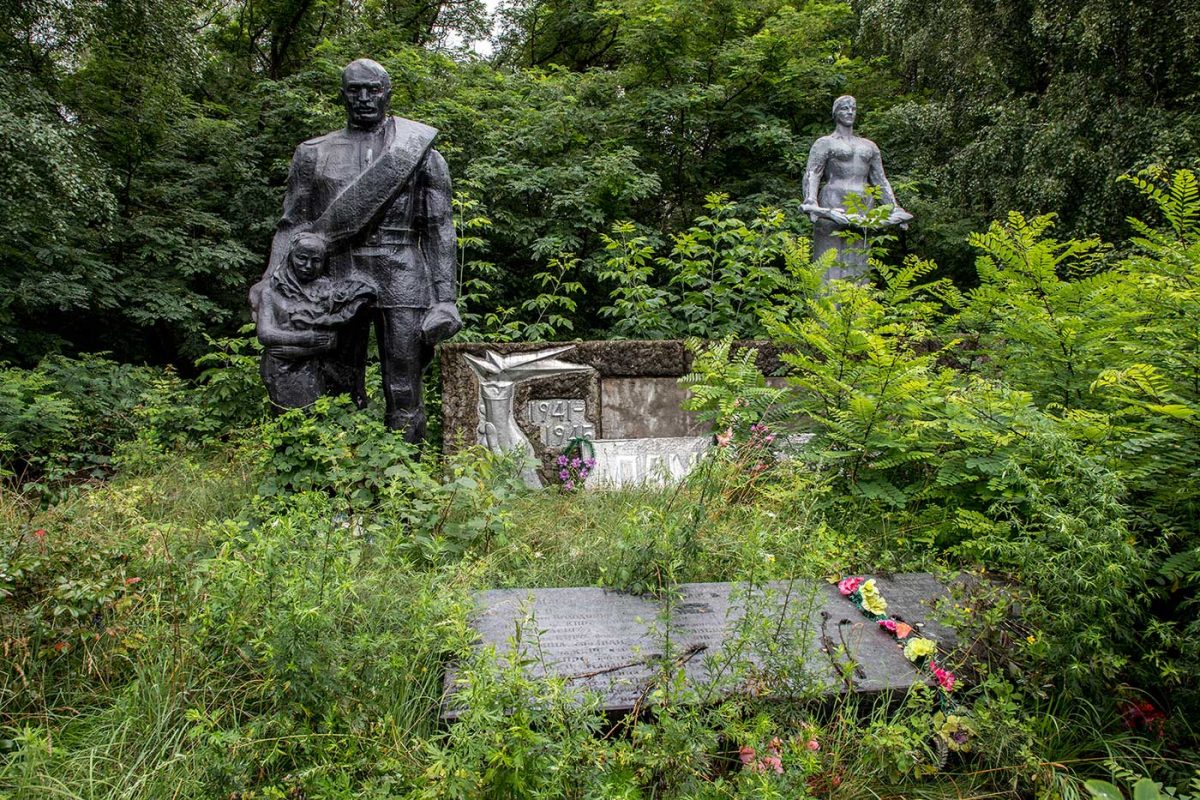
Poliske, Ukraine. On the town’s outskirts, stands this memorial dedicated to victims of the Great Patriotic War. A simple dedication reads: “1941-1945. We remember.” Statues arranged around the main memorial stone represent a soldier protecting a child, and a woman holding a wreath.
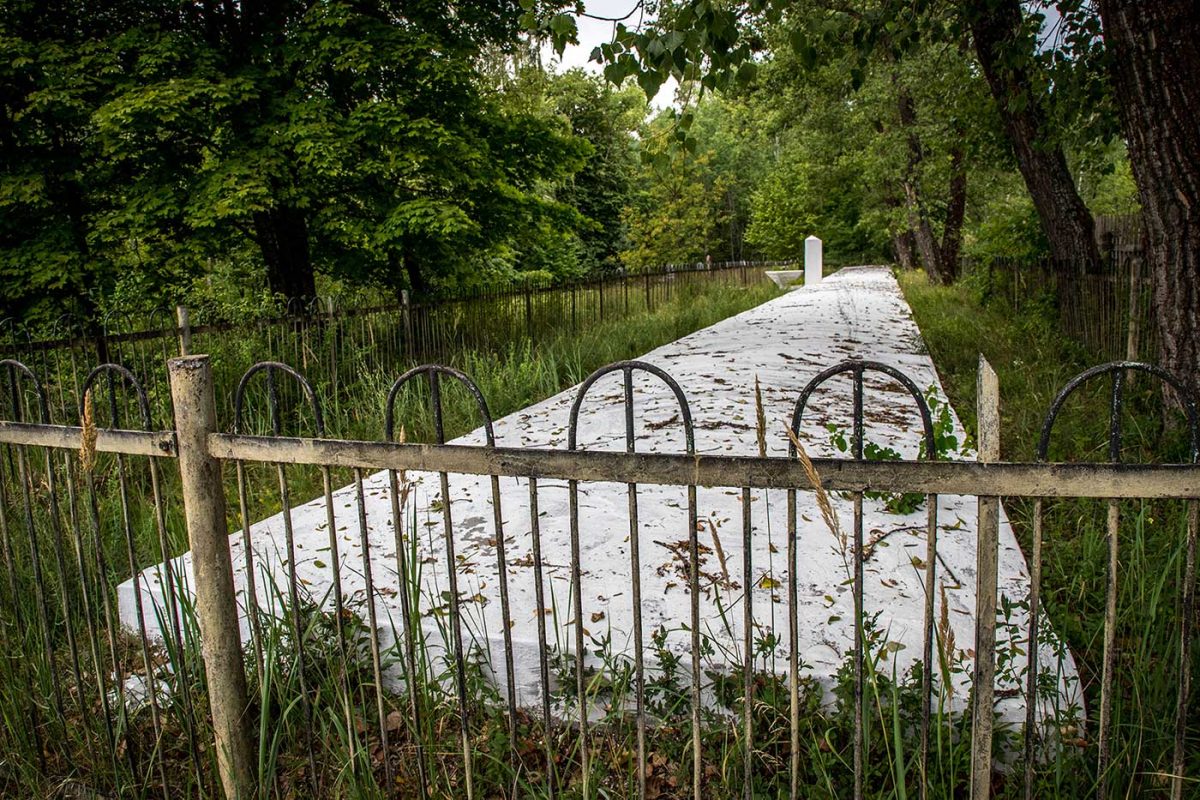
Jewish Memorial Barrow. Chornobyl, Ukraine. Before the war, the town of Chornobyl was an important centre for Hasidic Judaism in the region. Many Jewish citizens were murdered when the Nazis invaded and occupied the region beginning in 1941. After the war, most Soviet memorials were dedicated to the soldiers, while the Jewish tragedy was largely sidelined – in favour of a more political message, which presented the average Soviet citizen as the target and victim of Nazi aggression. However, alongside the Jewish cemetery in Chornobyl, this memorial barrow was established with the inscription: “Here lie the ashes of residents who were brutally murdered by fascists on 19 November 1941.” – Read more on: A Nazi’s Photographs of the Massacre at Babyn Yar – 80 Years of Amnesia and Erasure

Monument to Our Soldier-Countrymen. Park of Glory, Chornobyl, Ukraine. Before the creation of Pripyat in 1970, Chornobyl was the largest town here, and the region takes its name. The Park of Glory is a green space near the town centre, originally established to commemorate those who fought in the Great Patriotic War (though later, it would receive monuments to the victims of the Chernobyl disaster as well). The central installation in the park is the Monument to Our Soldier-Countrymen – a star-topped pillar before a sculpted red flag, which features the inscription: “To our soldier-countrymen who died on the fronts of the Great Patriotic War. 1941-1945.”
A memorial wall to the right of this pillar lists the names of fallen soldiers from Chornobyl, as well as those from elsewhere who died in the conflicts here. Its inscription reads: “The town of Chornobyl was liberated from the Nazi invaders on 16 November 1943, by the troops of the First Ukrainian Front under the command of General Nikolai Fyodorovich Vatutin.”
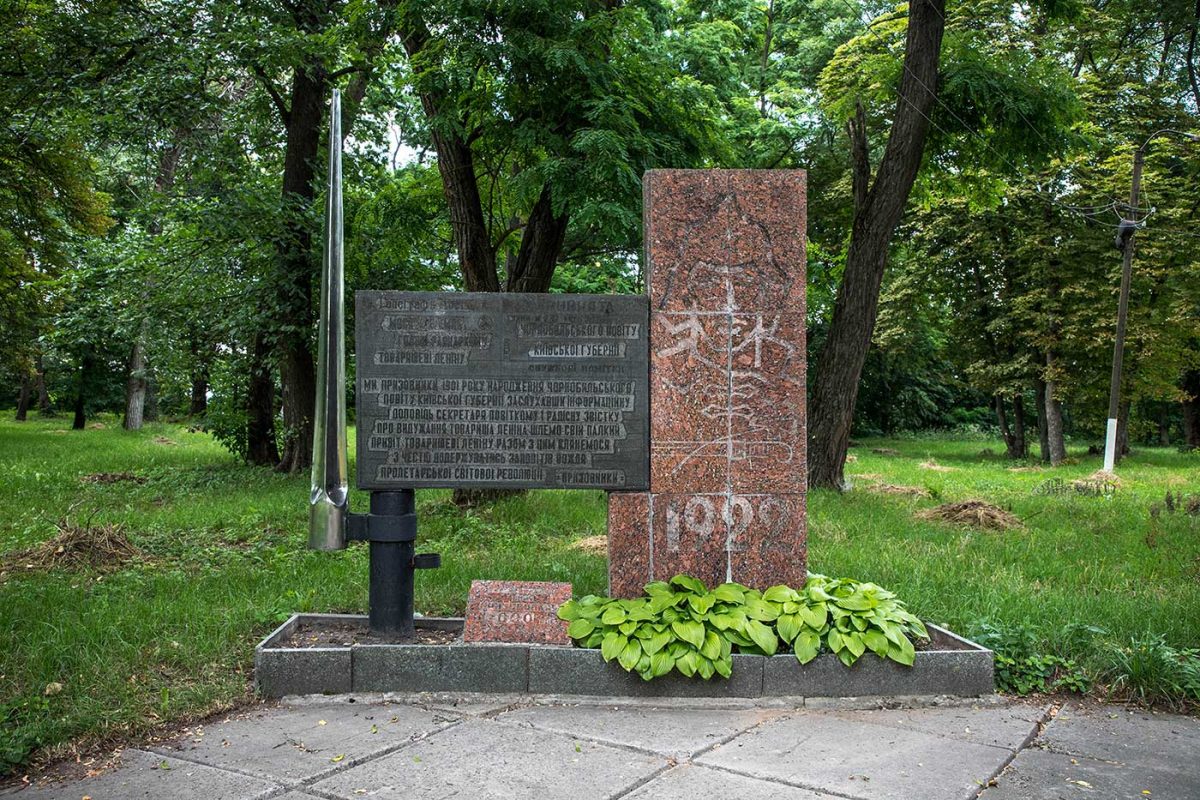
Monument to the Telegram to Moscow. Park of Glory, Chornobyl, Ukraine. Though not strictly a war memorial, this monument was added to the park in 1984 – two years before the disaster. It was designed by Taras Yukhymovych Myskovets and commemorates the sending of a telegram in 1922, from military conscripts in the Chernobyl region to “The Chairman of the Council of People’s Commissars, Comrade Lenin.”
The text reads: “We, recruits born in 1901 in Chernobyl district of Kyiv province, having heard the report of the district secretary and the joyous message about the recovery of Comrade Lenin, send our fervent greetings to Comrade Lenin, along with our vow to observe with honour the will of the leader of the proletarian global revolution. Signed: the Recruits, 1922.”
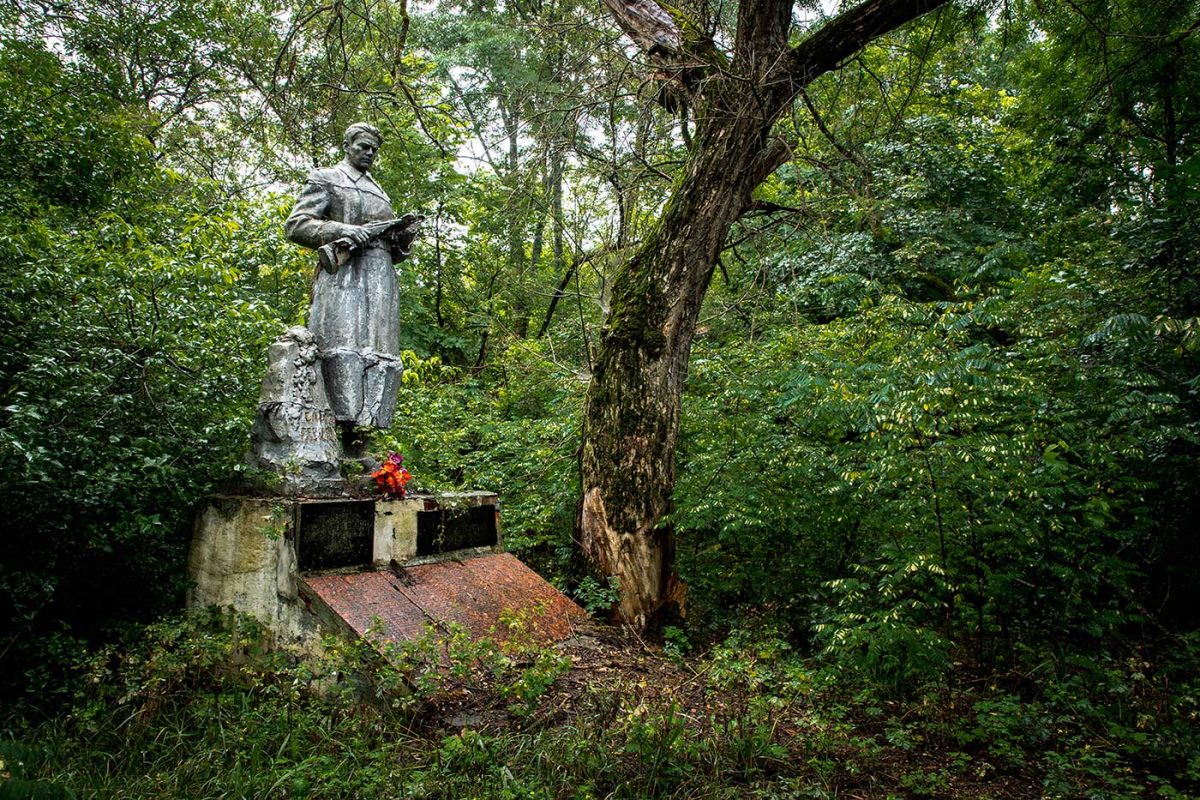
Chapayevka, Ukraine. Located in the centre of the former village, this monument features a solemn statue of a soldier, accompanied by the names of villagers who died in the war. An inscription reads: “Glory to the heroes. To the soldier-villagers who died on the fronts of the Great Patriotic War. 1941-1945. Eternal memory to those who saved the fatherland from fascism.” Former residents of the village have returned to leave plastic flowers at the soldier’s feet.
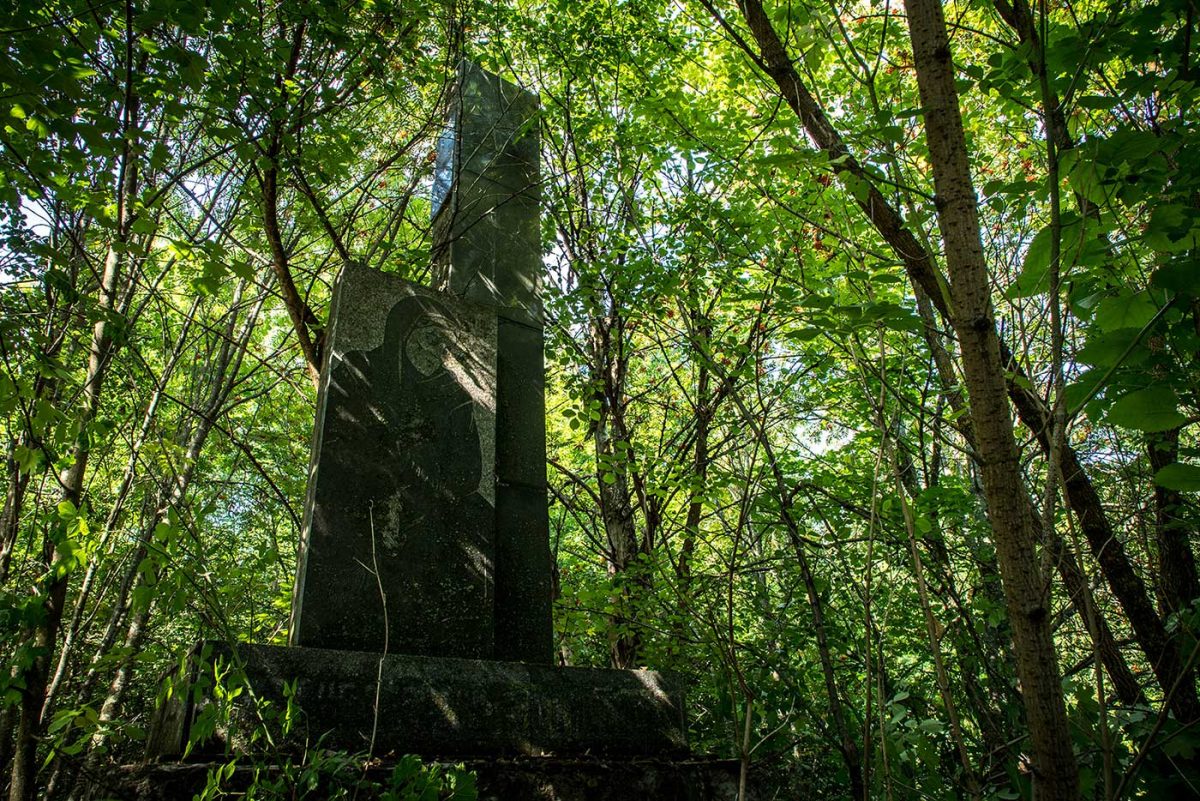
Dibrova, Ukraine. This black granite monument features the engraved likeness of a grieving mother. It was designed in the 1980s by Taras Yukhymovych Myskovets, who also created a similar monument for the village of Zalissya. An inscription reads: “No one is forgotten, nothing is forgotten.” Detailed photographs of the list of names can be found here.
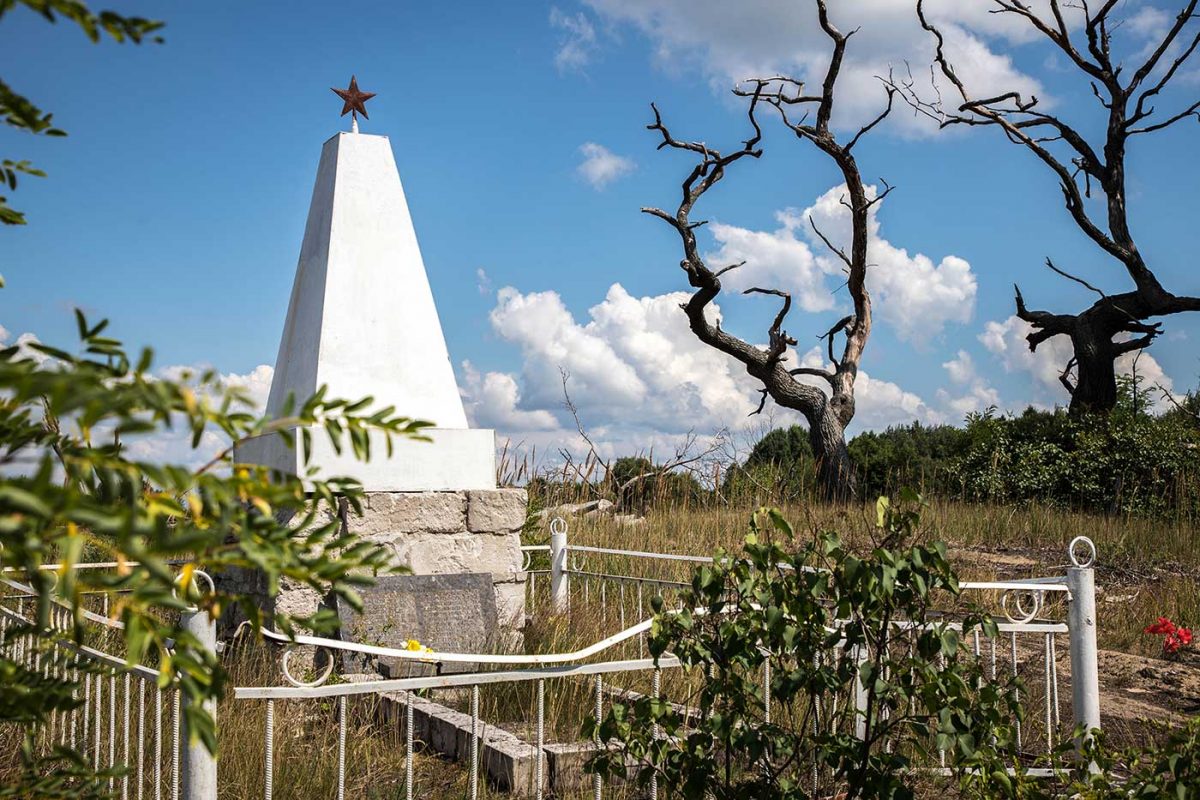
Gorodishche, Ukraine. Memorial obelisk located beside a cemetery on the edge of the village. Its caption reads: “Stop, bow low! They gave their lives for your happiness! Eternal glory to the soldier-villagers who died on the fronts of the Great Patriotic War. 1941–1945.”

Klyvyny, Ukraine. This village has become so overgrown by the forest, that the obelisk is now lost deep in the trees. Former residents have still found their way to it, however, to leave offerings of plastic flowers. The painted plaque appears to have been restored at some point in the years since the evacuation. It reads: “In memory of our fellow countrymen who were killed in the battles for the freedom and independence of our Homeland during the Great Patriotic War. 1941-1945.”
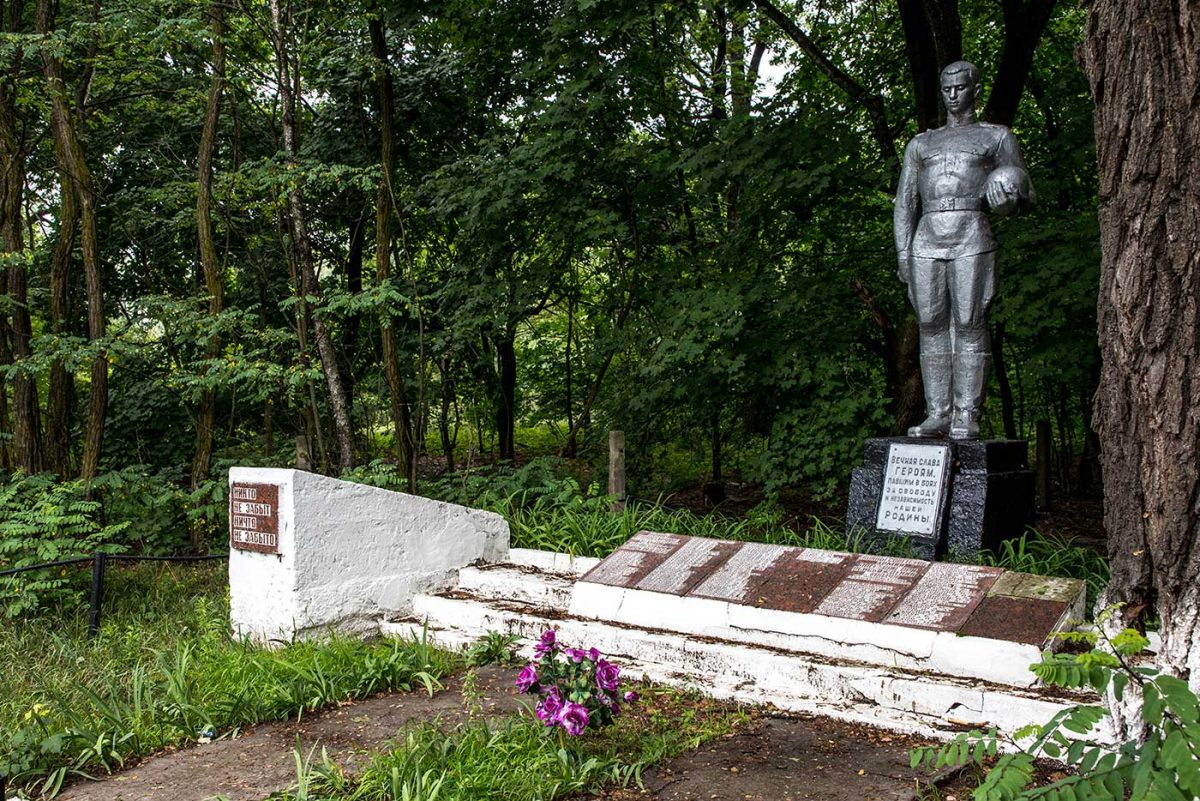
Kopachi, Ukraine. Of all the village monuments in the Zone, this one at Kopachi is perhaps the most visited today. The village itself was located close to the power plant, and due to high levels of contamination it was largely bulldozed and buried following the disaster. The village kindergarten remains though, and has long been a popular stop on Chernobyl tours. This monument stands immediately outside the kindergarten. The inscription beneath the central statue reads: “Eternal glory to the heroes who fell in the battles for the freedom and independence of our Homeland.”
The blocks positioned to the left and right of the main list of names read: “No one is forgotten, nothing is forgotten,” and: “Eternal memory for those who saved the fatherland from fascism.” On the main memorial panel, the list of names is divided into two columns: for residents of Kopachi who died in other battles of the war, and for Soviet soldiers who died during the 1943 liberation of Kopachi.
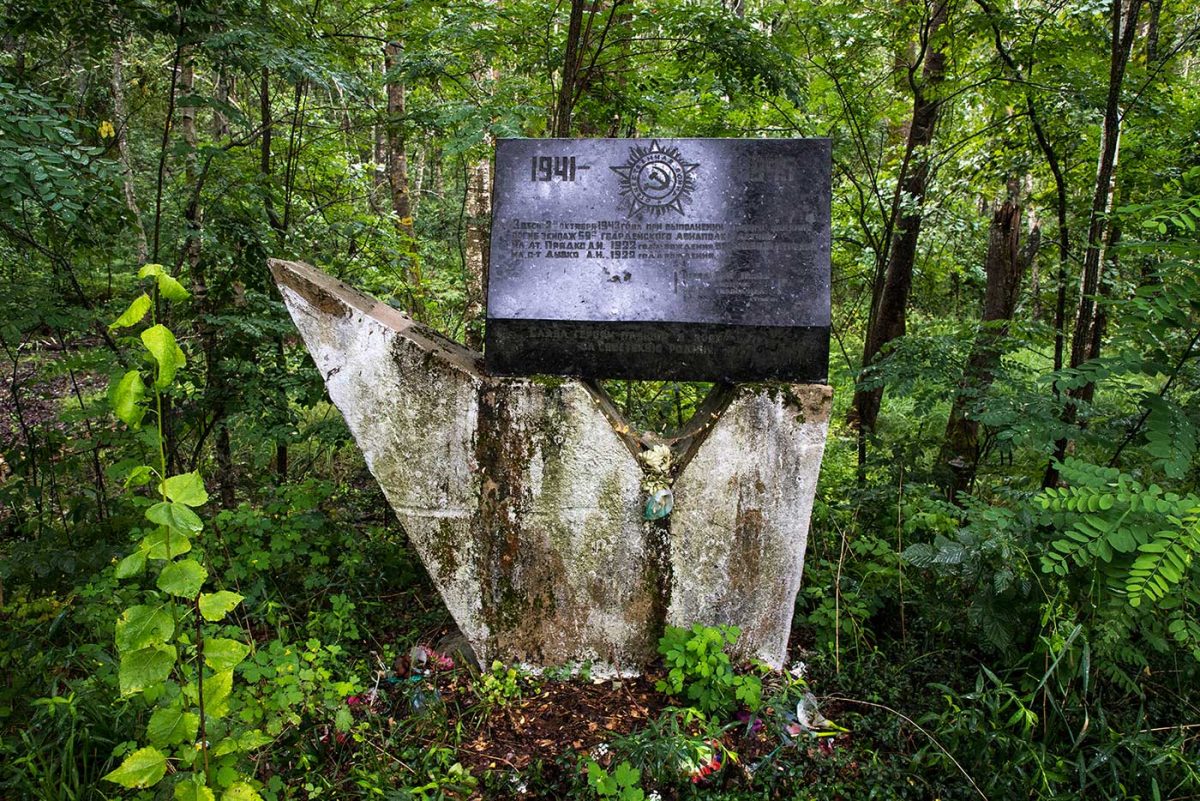
Kotsiubynske, Ukraine. This unusual monument marks the site where two Soviet airmen were downed in combat. “Here on 3 October 1943, while performing a combat mission, the crew of the 59th Guards Air Regiment was killed – the pilot Junior Lieutenant A. I. Pryadko, born in 1922, and flying gunner Junior Sergeant A. N. Dudko, born in 1922.” A further inscriptions adds: “Glory to the heroes who died in the battles for the Soviet Homeland.”
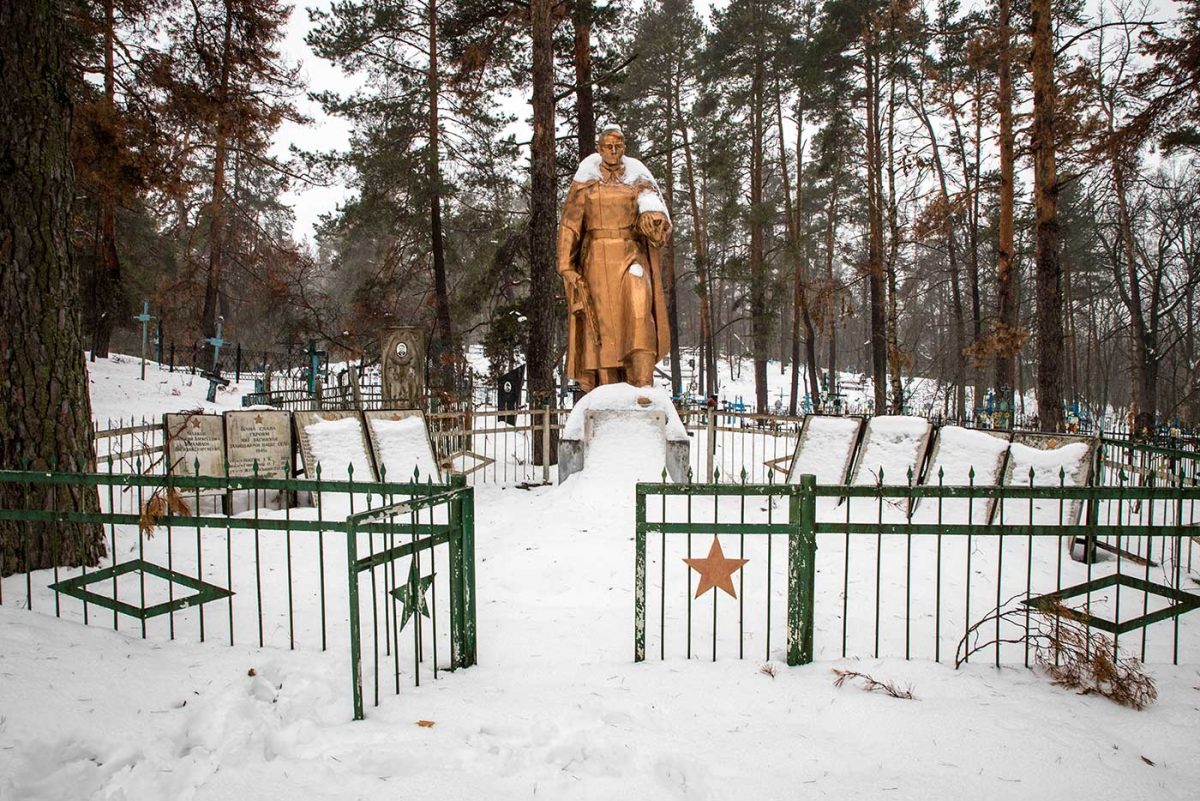
Kupovate, Ukraine. In the village cemetery, this monument to the Great Patriotic War has an inscription that reads: “Eternal glory to the soldiers who perished for the freedom and independence of our Homeland. 1941–1945.”

Ladyzhychi, Ukraine. The village of Ladyzhychi was held by a Nazi garrison during the war, but the local ‘Stalin’ partisan unit made numerous attempts to liberate it. In 1943, the Soviet Red Army arrived in force and defeated the Nazis at Ladyzhychi, though 72 Soviet soldiers were killed in the conflict. This monument was created in 1963. The statue of a soldier, measuring 2.5 metres, has since disappeared – leaving only the pedestal on which it stood. Here (in Russian) appear the words: “Eternal glory to the soldiers who died for the freedom and independence of our Homeland. 1941-1945.”
Alongside it, the 5-metre obelisk commemorates Pasha Osidach – a native of this village, who acted during the war as a messenger for the partisan detachment at Bragin. According to the story, Pasha would hide the messages in the braids of her long hair. In 1943 however, she was captured by Nazi forces in Belarus, and then subjected to torture and interrogation. When she still refused to reveal information, the Nazis buried her alive. She was later reburied here in Ladyzhychi, in 1965. The inscription on her obelisk, in Ukrainian, reads: “P. N. Osidach, 1924-1943. Partisan messenger.”

Monument to Pasha Osidach. Park of Glory, Chornobyl, Ukraine. In 1965, the partisan messenger Praskovya “Pasha” Nikolayevna Osidach was re-buried beneath an obelisk in Ladyzhychi. Two decades later, her family commissioned a more personalised monument to her, which was made from bronze, and designed by the region’s most prolific memorial artist, Taras Yefimovich Miskovets. However, the creation of the new monument in 1986 coincided with the disaster at the power plant, and Ladyzhychi was evacuated before it could be installed. The bronze monument was stored for some years, before being erected first on the site of Chornobyl school. More recently it was moved to the town’s Park of Glory, where it can be seen today.
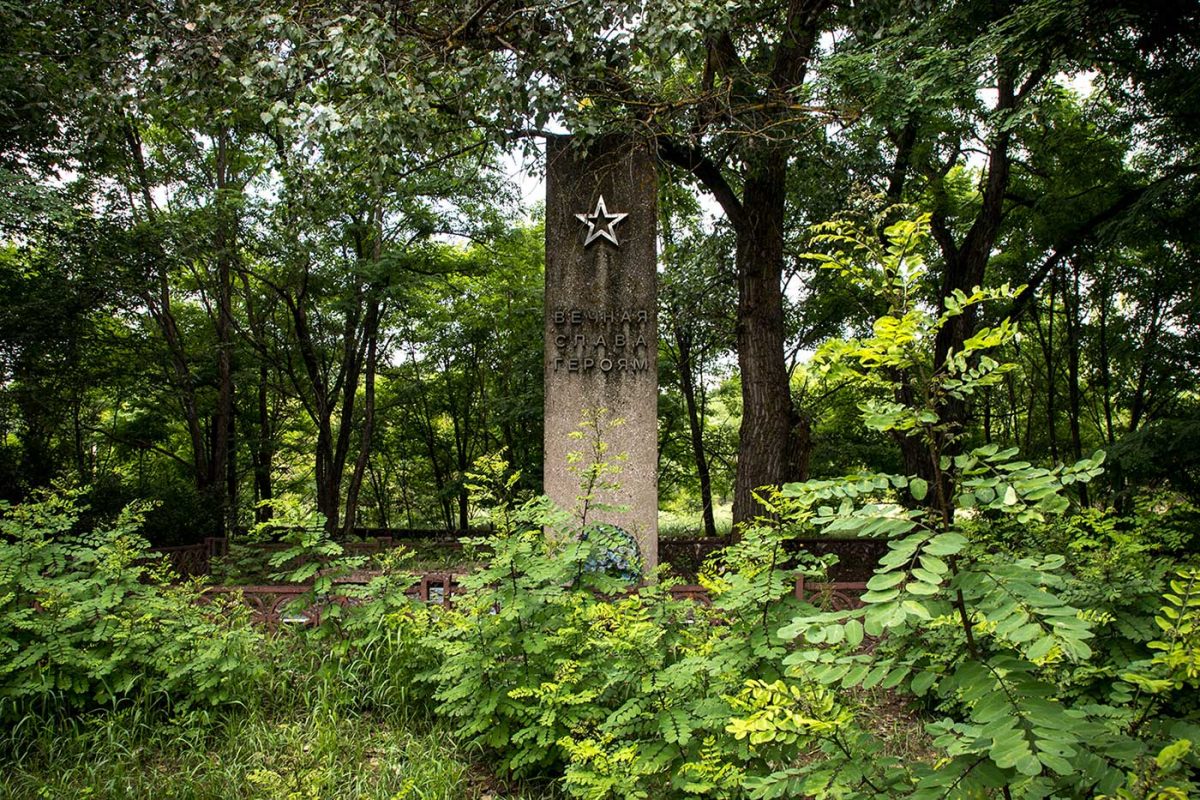
Nahortsi, Ukraine. The village of Nahortsi was evacuated a decade before the disaster – its citizens were relocated in the 1970s when the village was flooded to create the cooling reservoir for the Chernobyl Nuclear Power Plant. This war memorial that was originally located on the edge of the village, still stands today at the edge of the reservoir. It consists of a simple concrete panel with a metal star, and an inscription that reads: “Here in October 1943, the soldiers of the 310th Infantry Regiment of the 8th Infantry Division stood and defeated the enemy, under the command of Hero of the Soviet Union, Lieutenant-Colonel P. I. Zhdanov. Eternal glory to the heroes.”
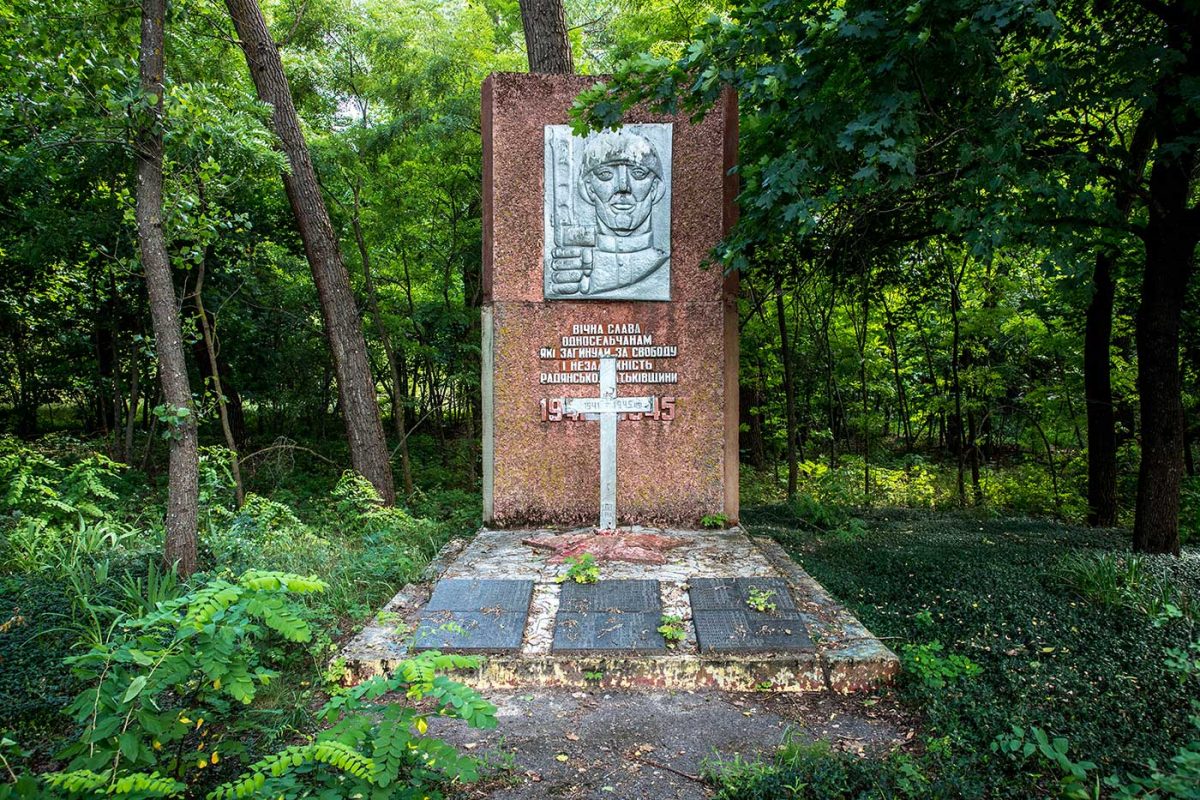
Opachychi, Ukraine. This memorial in the centre of the village reads: “Eternal glory to our fellow villagers who died for the freedom and independence of the Soviet Homeland. 1941–1945.” In 2002, this monument was modified with the addition of a Christian cross, which was welded directly onto a Soviet star.

Opachychi, Ukraine. In a cemetery on the village outskirts, this statue of a kneeling soldier bears the inscription: “1941-1945. Eternal glory to the heroes who fell in the battles for the freedom and independence of our Homeland.” Today it is decorated with plastic flowers, left by former residents.
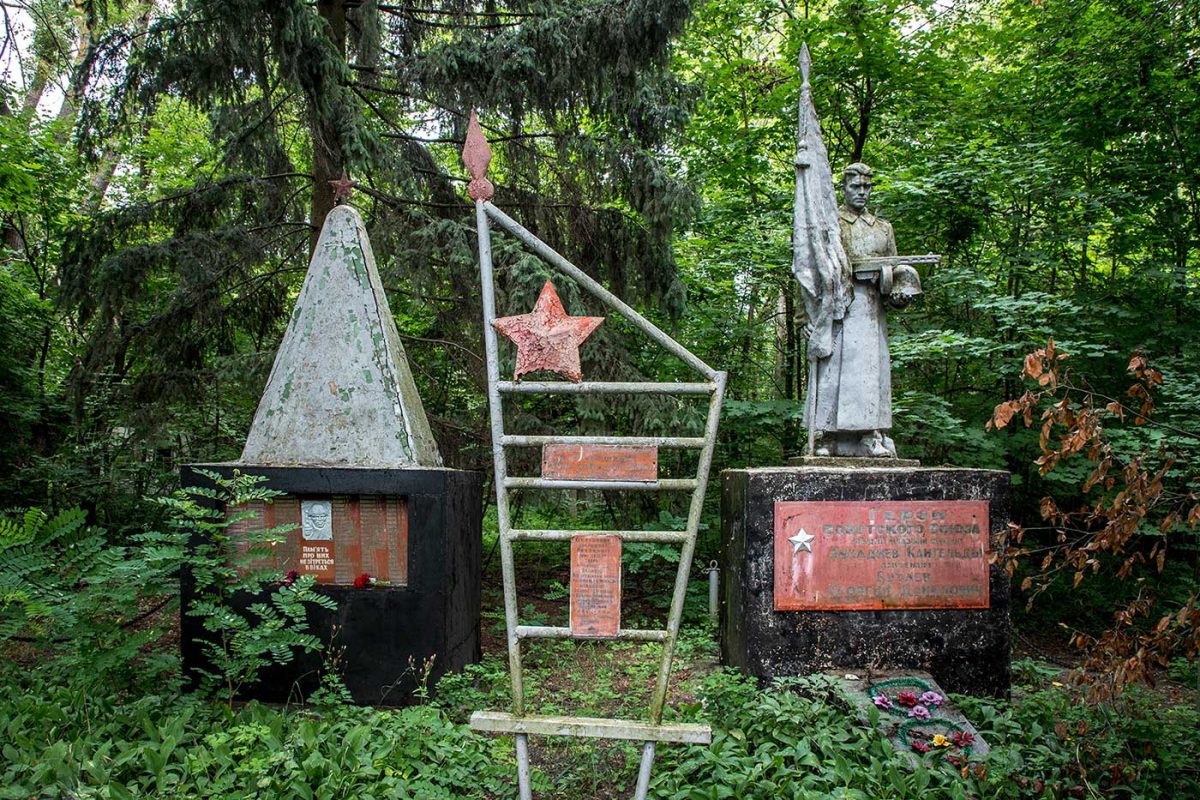
Paryshiv, Ukraine. Located at Paryshiv – a village in the north, close to the border with Belarus – this memorial site consists of an ensemble of three monuments. The obelisk on the left has an inscription in Ukrainian, and commemorates soldiers from this village. It reads: “Their memory will not be erased for centuries.”
On the right, the soldier’s statue carries a dedication in Russian: “In eternal memory of the soldiers of the Soviet army who fell liberating the village of Paryshiv.” It names two fallen soldiers as Heroes of the Soviet Union: Junior Sergeant Kaigeldy Aukhadiev and Lieutenant Georgi Danilovich Butaev.
The central trellis structure also carries text written in Russian. “Stop, passer-by! Worship this land! Here in the terrible years of the Great Patriotic War fought the brave soldier-guards of the 6th Red Banner Order of Lenin Rivne Order of Suvorov Rifle Division. Glory to you, brave, honoured, fearless, the people sing eternal glory to you! Valiant in life, victorious over death, your memory will never die!”
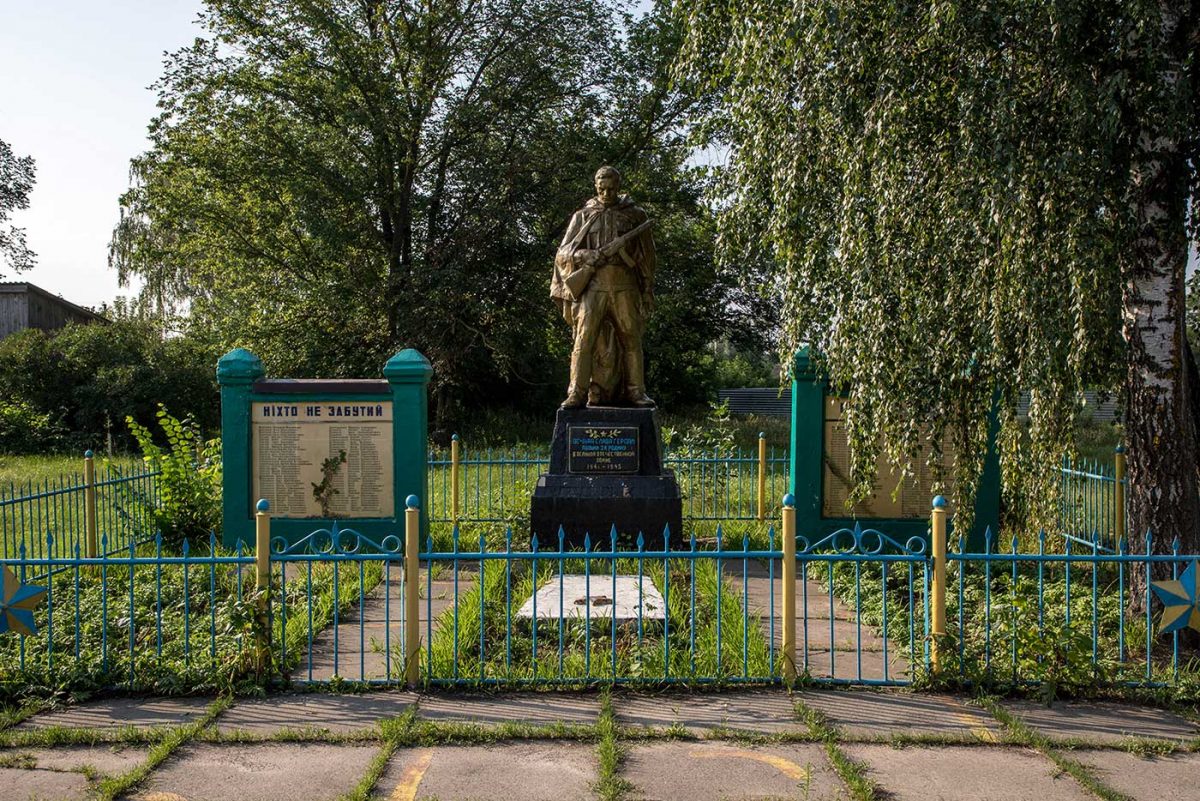
Orane, Ukraine. Orane is one of the more prosperous villages that sit just outside the border of the Exclusion Zone. Located 7 km from the checkpoint at Dytyatky, where tour buses enter the Chernobyl Zone, many local residents have found ways to capitalise on tourism, with a number of guesthouses and independent tour guides operating from this village. The village memorial is well maintained, and features the slogan “Nothing is Forgotten,” above a list of the names of the fallen.
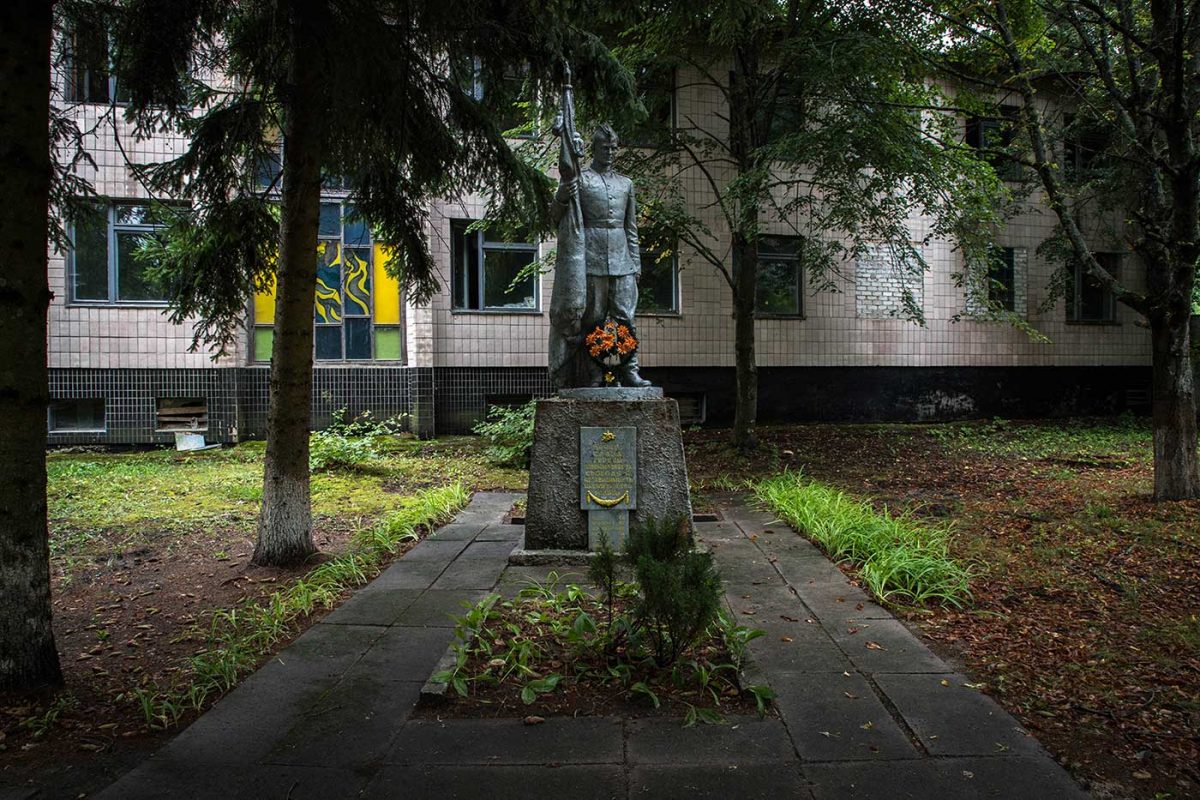
Poliske, Ukraine. Poliske was not originally part of the Exclusion Zone. However, due to the changing spread of contamination in the years after the disaster, the borders of the Zone were adjusted, and in 1993 the order was given to evacuate this town of almost 12,000 people. It now stands largely abandoned, although the former fire station is currently used as a training base for the Ukrainian National Guard. Outside that building is this war memorial, with the inscription: “Eternal glory to the heroes fallen in the battles for the freedom and independence of our great Homeland.”

Triumphal Arch. Poliske, Ukraine. This memorial arch was created in 1954, to commemorate the end of a much earlier conflict. It marks 300 years since the “Reunification of Ukraine with Russia” – referring to the 1654 Treaty of Pereyaslav, between Moscow and the Cossacks under Bohdan Khmelnytsky.
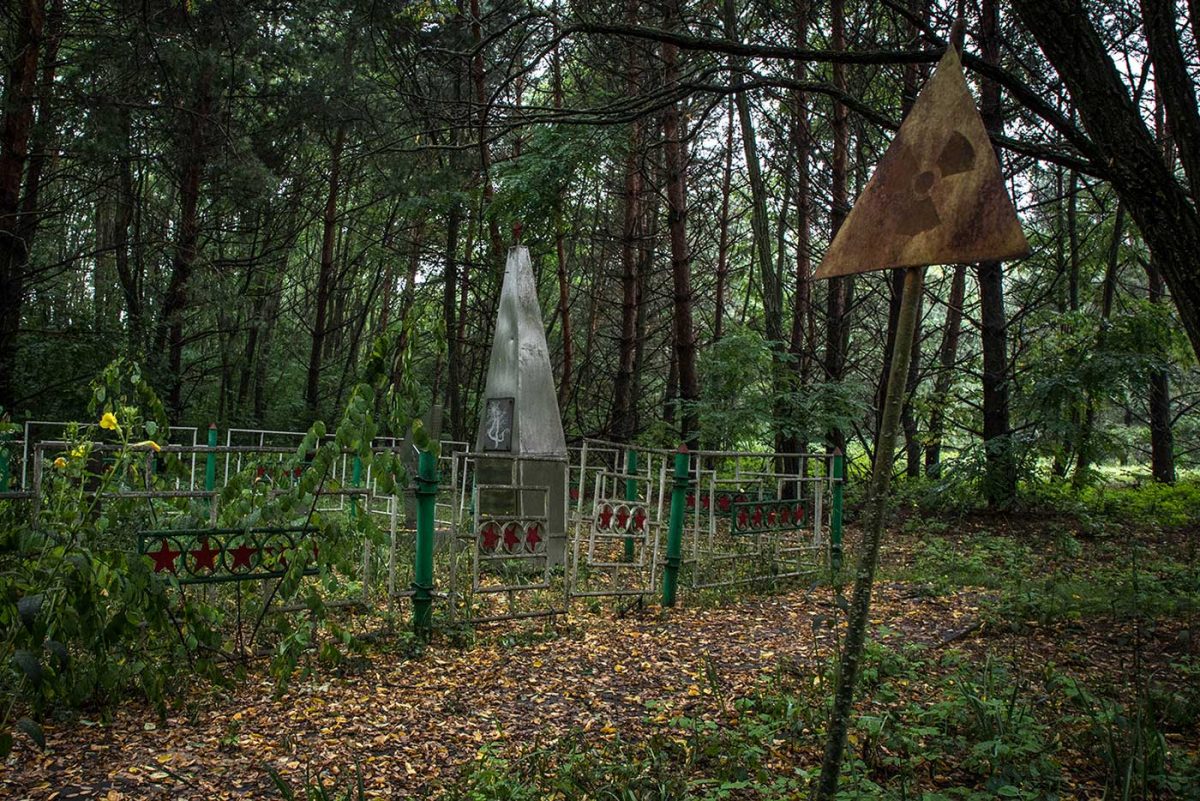
Pripyat, Ukraine. Situated between Pripyat and the power plant, this memorial site features a number of monuments dedicated both to the heroes of the Great Patriotic War, and added later, monuments to those who participated in the disaster clean-up after 1986. Prior to the war, this was the location of a distinctive three-trunked tree, which Nazi occupiers allegedly used to hang partisans from (a story which is explored in depth in Chernobyl: A Stalkers’ Guide). A likeness of that tree now appears on the main obelisk. An inscription reads: “Your names are known and your feat is immortal,” while other plaques commemorate specific military brigades (from the Carpathians and from Odessa) who joined the fighting here.
Post-disaster monuments appearing alongside the main obelisk use similar language to the war memorials, as they commemorate the actions of disaster clean-up crews: “No one is forgotten, nothing is forgotten – Dedicated to the Engineering Technician Battalion of Siberian soldiers who participated in the liquidation of the consequences of the Chernobyl accident, March 1987.”
A newer plaque summarises the two events: “Glory to the hero-partisans! Your feat will be forever remembered, here in the staging area for the liquidation of the accident at the Chernobyl Nuclear Power Plant.”
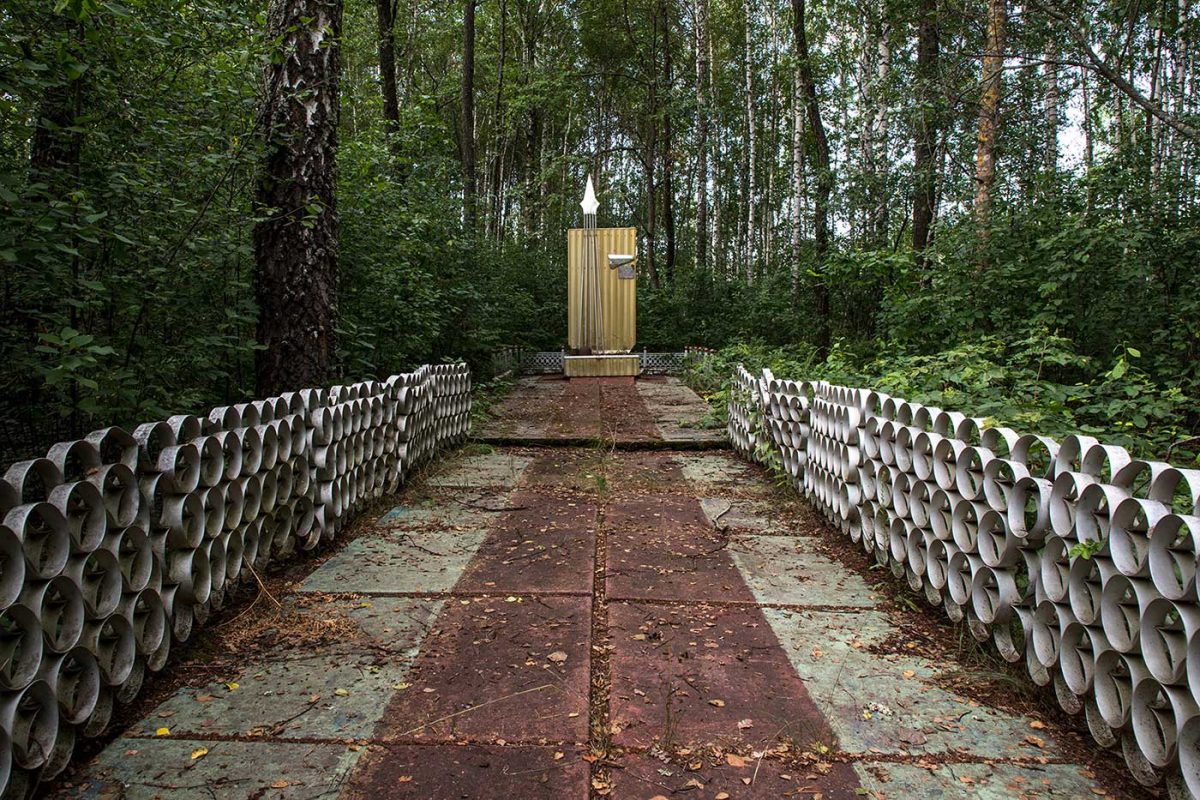
Rudnya Illinetska, Ukraine. This unusual monument is formed from upright wooden panels, painted gold, and affixed with polished metal details. It commemorates the place where a Soviet fighter pilot was downed during the Great Patriotic War. An original inscription reads: “Passer-by! Bend your head before the grave where lie the remains of an unknown Soviet pilot killed on 4 October 1943, when our Homeland was liberated from German fascist invaders.” However, it seems that the pilot’s identity was later discovered, as another, more recent-looking plaque, adds: “Junior Lieutenant Kurbanov Safar Abutalyb-ogly. 4.10.1923-1943.”

Stechanka, Ukraine. This interesting flame-shaped monument in the village of Stechanka (also note the star-shaped metal support) commemorates: “Our soldier-countrymen who died on the fronts of the Great Patriotic War.” It features a very long list of names, along with a verse: “Let us remember everyone by name / With our sorrow we will remember / This is not in service of the dead / This is needed by the living.”

Teremtsi, Ukraine. During the war, two men from this village joined the Nazi-allied police force and they were instrumental in helping to capture a local antifascist partisan brigade. The partisans were held prisoner in a house here, before being executed without trial. This monument was built in the place where that prison-house once stood. It takes an unusually expressionistic style, with the dates “1941-1945” on its pillar, a list of names of the fallen on its base, and beneath a plate that once held a ceremonial flame, an engraved poem reads: “In the memory of the stone / In the memory of the heart / Each of these names will never be erased.”
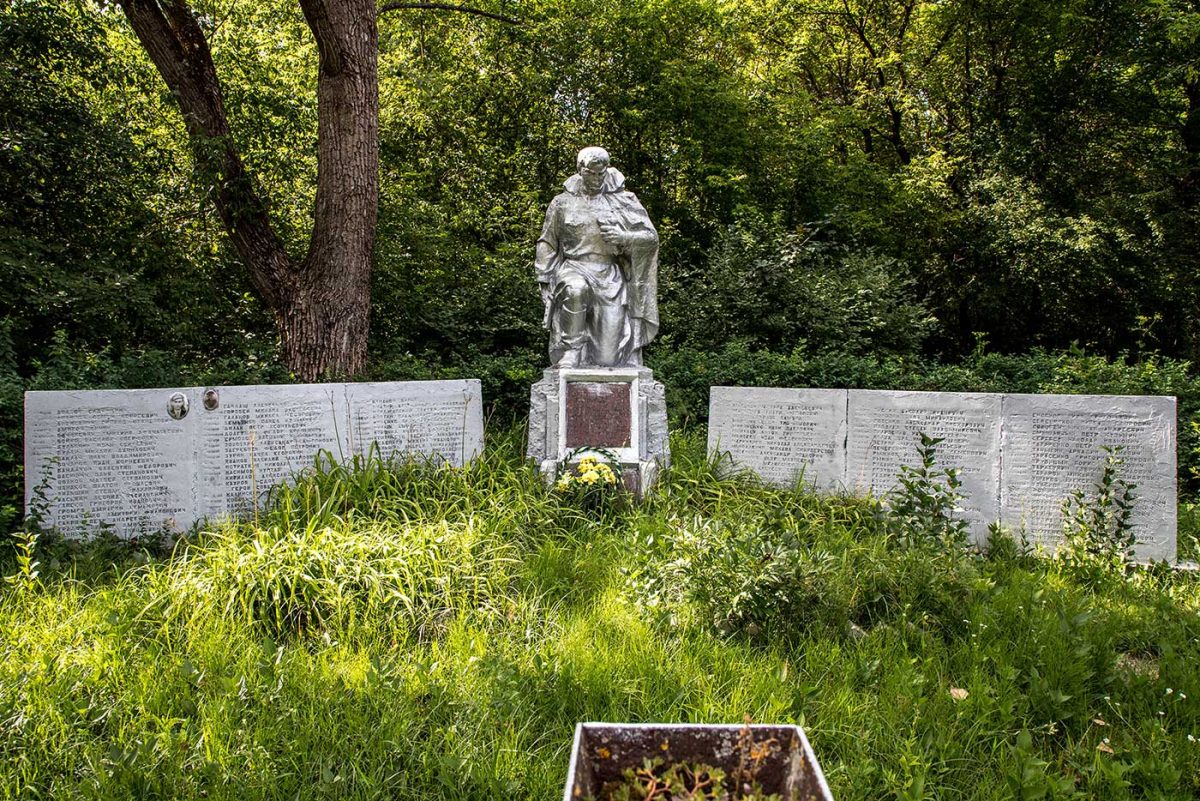
Zalissya, Ukraine. The village of Zalissya is located just south of Chornobyl, and this monument overlooks the main road into the town from the direction of Kyiv. As a result, tour buses pass in front of the monument, and it is visited more often than most memorial sites in the Zone. Its inscription reads: “During the Great Patriotic War in November 1943, the soldiers of the Rivne Order of Lenin Red Banner Order of Suvorov Division, fought heroically on this land. Many of them gave their lives for our bright future. Eternal glory to the fallen heroes!”
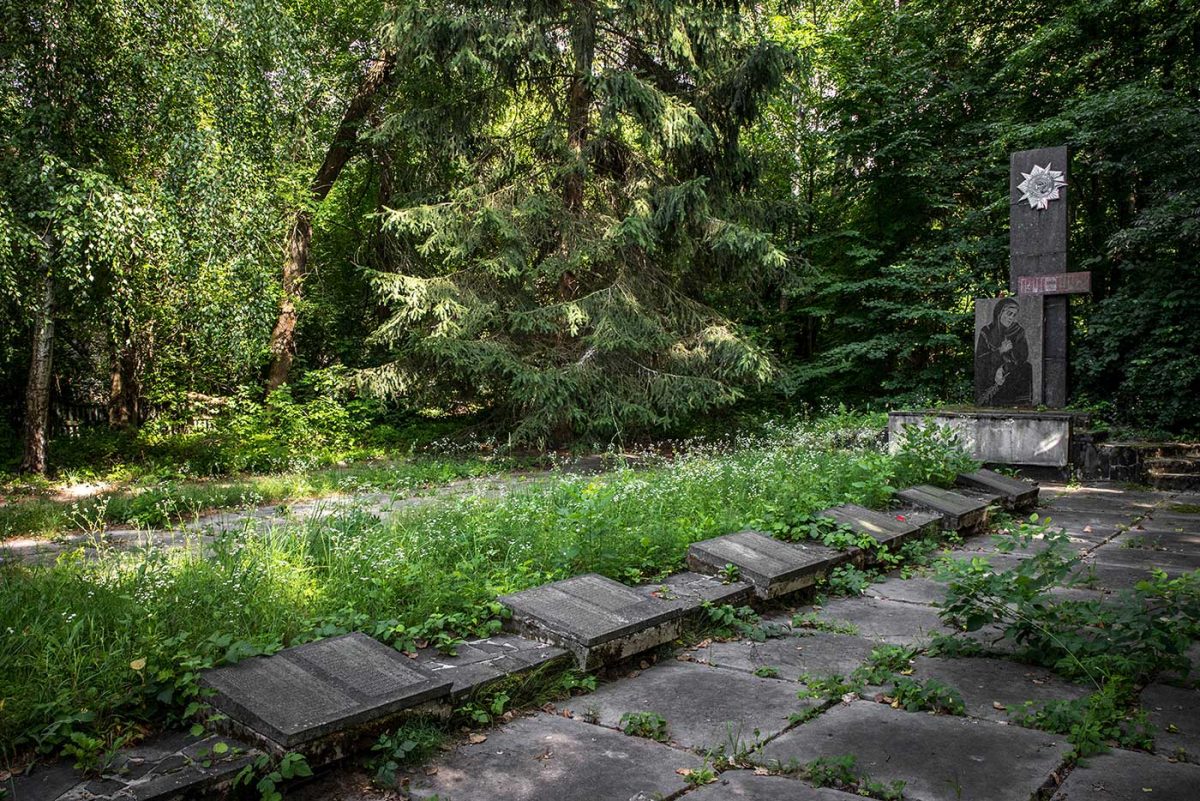
Zalissya, Ukraine. Nearby, on the opposite side of the road, appears this memorial designed by Taras Yukhymovych Myskovets. Created in 1985, the central composition consists of black granite slabs engraved with the face of a grieving mother, and the words: “To the soldier-villagers who died on the fronts of the Great Patriotic War.” The design of this monument is very similar to the one at Dibrova, by the same author.
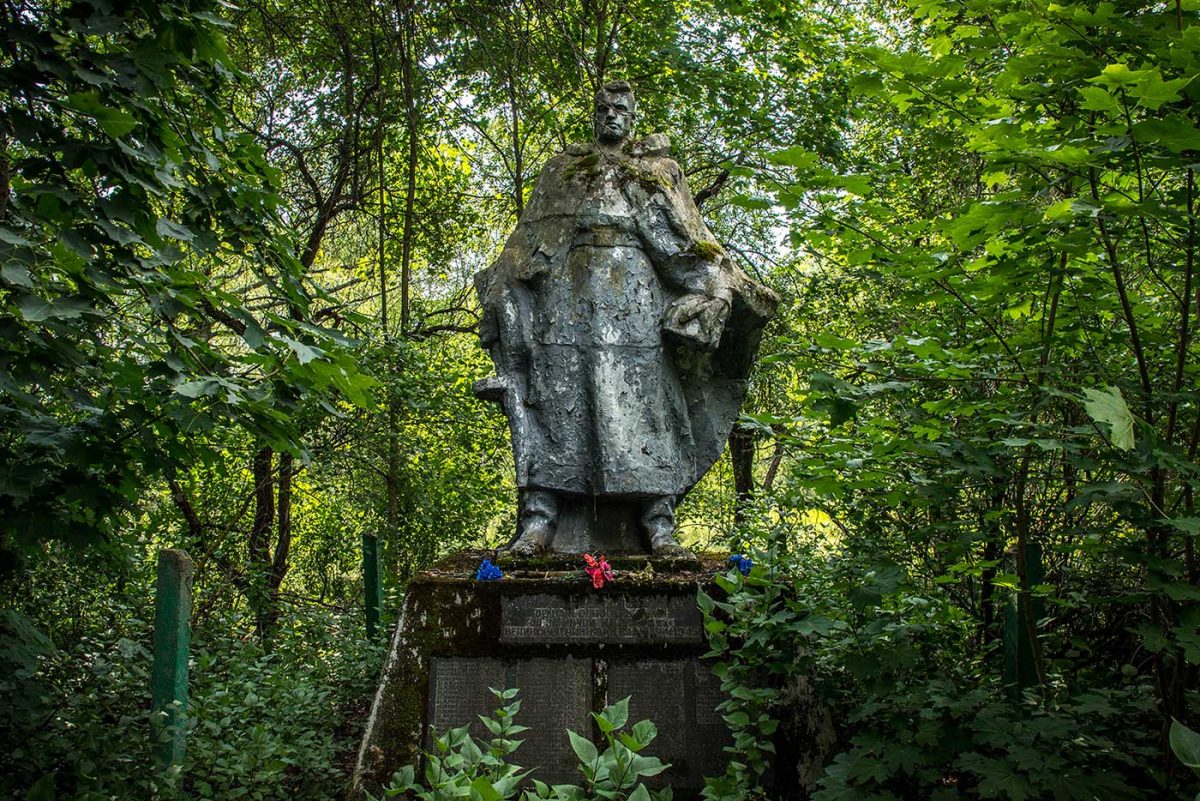
Zamoshnya, Ukraine. In November 1943, units of the 13th Army 151st Infantry Regiment liberated the village of Zamoshnya (an Old Believers settlement) from the Nazi invaders. In the battles for the liberation of the village, six Soviet soldiers were killed. They were later buried here in a mass grave. This statue of a soldier, made from reinforced concrete and measuring 2 metres in height, was added in the 1960s along with a marble commemorative plaque. A slogan in Ukrainian reads: “Eternal glory to the soldier-villagers who died on the fronts of the Great Patriotic War. 1941-1945.”
Beneath, a dedication is made in Russian to the six soldiers who died in combat here: Privates Gonchar, Korkishko, Kurnosov, Muravyev, Hahaev, and Petrov. “Eternal glory to the soldiers of the Soviet Army, who perished liberating the villages of Zamoshnya and Glinka from the Nazi invaders, November 1943.”
You can see more pictures and read more about this fascinating project in Darmon’s book: Chernobyl: A Stalkers’ Guide (FUEL, 2020).
Would you like to support Flashbak?
Please consider making a donation to our site. We don't want to rely on ads to bring you the best of visual culture. You can also support us by signing up to our Mailing List. And you can also follow us on Facebook, Instagram and Twitter. For great art and culture delivered to your door, visit our shop.






